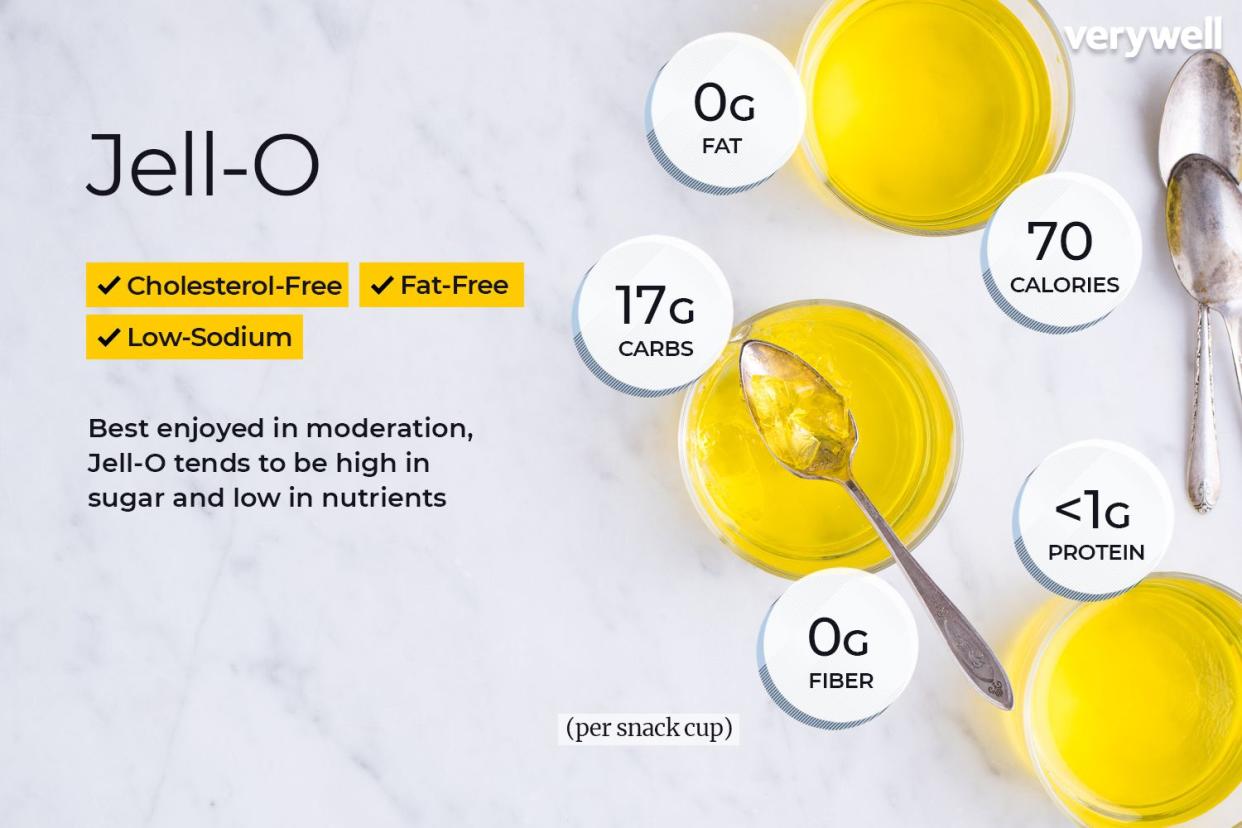Jell-O Gelatin Nutrition Facts and Health Benefits

Verywell / Alexandra Shytsman
Medically reviewed by Jonathan Valdez, RDN, CDCES, CPT
Jell-O gelatin is a refreshing, sweet snack, though it has little nutritional benefit. It has about 70 calories unless you opt for a sugar-free version with about 10 calories.
Some have expressed concern that the artificial coloring in products like Jell-O gelatin can cause problems, but those concerns have been debunked.
Nutrition Facts
Kraft/Heinz, the company that makes Jell-O, provides the following nutrition information for one serving (96g)—one snack cup—of Jell-O brand original raspberry gelatin.
Calories: 70
Fat: 0g
Sodium: 40mg
Carbohydrates: 17g
Fiber: 0g
Sugars: 17g
Protein: <1g
Carbs
There are 17 carbohydrates in one snack cup of raspberry Jell-O gelatin. This amount comes almost entirely from added sugars. Jell-O gelatin flavors that are labeled "sugar-free" contain 0g carbohydrates.
Fat
Jell-O gelatin on its own is a fat-free food. It is important to note that other Jell-O brand products, such as pudding or other dessert products, might not be fat-free. Always read the Nutrition Facts label to know exactly what your product contains.
Protein
Jell-O gelatin is not a significant source of protein.
Vitamins and Minerals
There are no significant vitamins or minerals contained in Jell-O gelatin. Some recipes involving homemade Jell-O gelatin might call for adding fruit, which can increase the nutritional benefit.
Calories
While sugar-free Jell-O gelatin can have as few as 10 calories, regular Jell-O gelatin sweetened with sugar has about 70-80 calories per serving.
Gelatin is made by extracting collagen from Jell-O brand gelatin products are made using animal products, so those who are vegan or vegetarian may not want to consume the Jell-O brand gelatin. It is also not accepted for those who eat a kosher or halal diet because some animal products are derived from pork.
Health Benefits
Since Jell-O does not have a significant amount of macronutrients or micronutrients, its benefits are limited. It can be an excellent way to satisfy a sweet tooth, especially if you choose a low-calorie, sugar-free version because it leaves room in your daily caloric needs for more nutrient-dense foods.
There is evidence that gelatin might help build the collagen protein that composes tendons, ligaments, and bones. However, more research is needed to understand how much gelatin provides this benefit, when it should be consumed, how it works, and more.
Allergies
Although rare, allergic reactions to gelatin have been reported. Gelatin is one potential cause of an allergic reaction to vaccines, such as the measles, mumps, and rubella (MMR) vaccine, many of which use gelatin as a stabilizer. Some products used during surgery can contain gelatin as a stabilizer, so if you are concerned you might have a gelatin allergy, consult a healthcare professional.
Because Jell-O gelatin contains collagen products derived from meat, people with Alpha-Gal syndrome, an allergy to red meat, might experience reactions to gelatin. One cause of Alpha-Gal syndrome is tick bites.
Adverse Effects
While there are no "bad" foods, Jell-O is relatively low in nutrients for the number of calories it provides, particularly the regular, non-sugar-free varieties.
Added Sugar
For all of its presumed benefits, Jell-O gelatin is a source of empty calories. Empty-calorie foods like Jell-O gelatin provides energy in the form of added sugar, usually a lot of it. The American Heart Association recommends no more than six teaspoons (25 grams) of added sugar per day for women and nine teaspoons (38 grams) for men. One serving of Jell-O gelatin has 17 grams.
Artificial Colors
Some dyes used in different flavors of Jell-O gelatin can interfere with some screening tests, particularly colonoscopy. Red and green Jell-O gelatin can sometimes turn your stool reddish or greenish. This can interfere with direct imaging tests like a colonoscopy by tinting the lining of your intestines. The same may occur with orange or purple Jell-O gelatin. Before a colonoscopy, you should receive instructions on how to prepare from your doctor. These will indicate whether you can consume Jell-O gelatin and, if so, what colors.
Varieties
Jell-O gelatin comes in various flavors, preparations, and formulations. Flavor profiles range from raspberry and cherry to innovative flavors like mango, peach, and blue raspberry sour.
You can buy Jell-O gelatin in prepared snack cups, typically in a pack of four. Another way to prepare Jell-O is to buy the powder mix in a box, which must be prepared at home by adding hot water until the powder dissolves, followed by cold water, then chilling in the refrigerator while it sets. Follow package instructions.
Regular Jell-O gelatin contains added sugar, while sugar-free Jell-O gelatin uses artificial sweeteners. Each caloric profile will be different, so check the package of the particular product to see how much sugar it contains.
Storage and Food Safety
Jell-O gelatin in snack cups should be stored in the refrigerator. Freezing Jell-O gelatin is not recommended because it would affect the product's texture. It should be consumed by the "Use By" date on the package, whether a snack cup or a Jell-O gelatin mix.
How to Prepare
If you like Jell-O gelatin but want to power up its nutritional profile, you can make your own with fresh fruit juice and powdered gelatin. This can significantly improve the nutritional value, especially if you stir in fresh berries, bananas, or yogurt.
